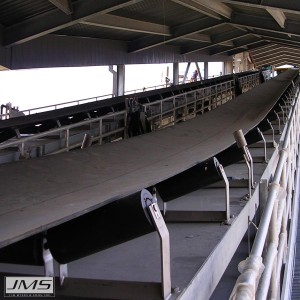Since the nineteenth century belt conveyors have been used as an effective method for transporting bulk materials, and are now one of the most widely used and efficient means of transporting compactable and granular solids. Water and wastewater treatment facilities have made good use of this type of conveyor for transporting dewatered biosolids, sludge, screenings or grit.
Dewatered sludge cake can consist of wastewater plant biological sludge from the treatment of municipal wastewater, or dewatered water treatment plant sludge. Dewatered sludge cake solids content ranges from 10% to 30% solids depending on the dewatering system used. A properly designed conveyance system with the ability to handle the special characteristics of sludge is critical to effective transport of material through the process.
The extensive use of stainless steel in construction, including platforms and structure, of JMS Bio-BELT (Belt Conveyor System) makes them a great choice for any industry conveying corrosive material. JMS can specially design a custom conveyor or full system to meet the needs of your process.
Bio-BELT (Belt Conveyor System) Key Features

Heavy Duty Idlers
• Stainless steel support frames
• Non-stick nonmetallic rolls
• CEMA compliant
• Sealed for life

Troughed Belt
Represent the most cost-effective option available and are ideally suited for straight runs, long conveyors, or conveyors with plows.

Side Wall Belt
Used when transitions from horizontal to incline are needed. Walls act to contain the material throughout and eliminate the need for skirtboards.

Cleated Belt
Cleated belts with sidewalls allow for inclines greater than 30°.
Greg Hyde joined the JMS Sales and Marketing Team as Product Manager | Material Handling. Greg has over 30 years of experience in material handling systems, having held high level engineering, sales and business management positions with large full line conveyor manufacturers. He is responsible for overall support and growth of the JMS Bio-HANDLING product line. Outside of work, Greg is a founding member of the “Jammin’ 4 Water” (Water Charities Fundraising Inc.). In regards to his position, Greg says, “ JMS has a rich history in design, quality and material handling. I’m excited to be part of this great team and look forward to guiding the Bio-HANDLING product family for long-term growth.”
